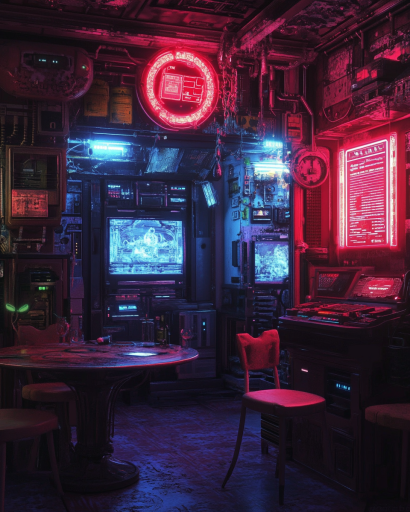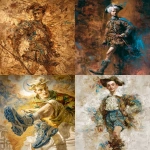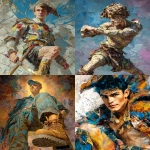Explore the Best AI Image Gallery

AI-generated Visual Content: Transforming Creativity and Industry
In recent years, the rise of artificial intelligence (AI) has revolutionized numerous sectors, and the creative industry is no exception. AI-generated visual content encompasses various forms of media, including images, videos, and animations, which are created and manipulated through advanced algorithms and machine learning techniques. This blog post explores the impact of AI-generated visual content on the creative industry, its potential applications, ethical considerations, and future trends in this rapidly evolving field.
The Impact of AI on the Creative Industry
Traditionally, the creative industry relied heavily on human talent and expertise to produce visual content. However, the integration of AI tools has significantly altered this landscape. Here are a few ways AI is making waves in creativity:
- Enhanced Creativity: AI algorithms can analyze vast datasets of art and media to identify patterns, trends, and styles. This capability assists artists in generating new ideas, often leading to innovative collaborations between human creativity and machine intelligence.
- Speed and Efficiency: AI can automate time-consuming tasks such as image editing, color correction, and content curation, allowing creators to focus on more complex creative aspects. With AI, projects that once took weeks can now be completed in a fraction of the time.
- Cost Reduction: The use of AI in content generation often reduces the need for expensive software and talent. Businesses can leverage AI tools to produce high-quality visual content at a lower cost, making creativity more accessible.
Potential Uses of AI-generated Visual Content
The applications of AI-generated visual content are vast and diverse. Here are some notable examples in various industries:
- Marketing and Advertising: Brands are using AI-generated visuals to create personalized marketing campaigns. These AI tools can analyze consumer behavior and preferences, generating targeted imagery that resonates with specific audiences.
- Video Games: The gaming industry is exploring AI-generated graphics to create dynamic, immersive environments. AI can also be used to generate non-player character (NPC) behaviors and animations, enhancing user experiences.
- Fashion: AI is being employed to design clothing lines, develop virtual fashion shows, and even create customized fashion items based on individual preferences.
- Film and Animation: AI-generated content is making its way into film production, aiding in script analysis, storyboard creation, and even editing, allowing filmmakers to push the creative boundaries of storytelling.
Ethical Considerations
While the advancements in AI-generated visual content offer numerous benefits, they also raise ethical questions that need to be addressed. Some of the key considerations include:
- Copyright Issues: Who owns the rights to AI-generated content? This question complicates the legal landscape, as traditional copyright laws do not clearly apply to machine-generated works.
- Misrepresentation: AI-generated visuals can be used to create misleading or deceptive content, presenting challenges in areas like news media and social platforms. Ensuring authenticity and transparency is crucial.
- Job Displacement: As AI takes on more creative tasks, there are concerns about job loss among creatives. Striking a balance between leveraging AI and preserving human artistry is vital for the industry’s future.
Future Trends
Looking ahead, we can expect several exciting trends in the realm of AI-generated visual content:
- Collaboration between Machines and Humans: Future creative processes will likely involve collaboration between AI and human artists, enriching the creative landscape with diverse perspectives and techniques.
- Improved Algorithms: As machine learning algorithms evolve, we will see increasingly sophisticated AI tools capable of generating more nuanced and complex visual content.
- Virtual and Augmented Reality: The integration of AI with virtual and augmented reality platforms will lead to more interactive and engaging visual experiences, blurring the lines between real and artificial environments.
- Increased Personalization: AI will continue to enhance the ability to create personalized content tailored to individual preferences and behaviors, radically changing consumer interactions with visual media.
Conclusion
AI-generated visual content represents a paradigm shift in the creative industry, offering new opportunities while also presenting significant challenges. As technology advances, the collaborations between AI and human creativity will shape the future of artistry in unprecedented ways. Embracing this transformation will require ongoing discussion about ethical practices, ownership rights, and the role of artistry in an increasingly automated world. The journey ahead promises innovation and opportunity, truly transforming how we create and interact with visual content.
](https://images.ai-img.art/thumbnails/150/3a60737a5b67fa252207ad1ae6db245a26284f53fb5846996bb34515b39ff269.webp)






](https://images.ai-img.art/thumbnails/150/8c3bd422d50d35735d8fb33bd314a79e30e5b150129d5d09bdad822a2007593f.webp)
](https://images.ai-img.art/thumbnails/150/1614d64dd7156c95db952258978be809eb3db8cea4453fec69c49cbdfe63fa94.webp)



